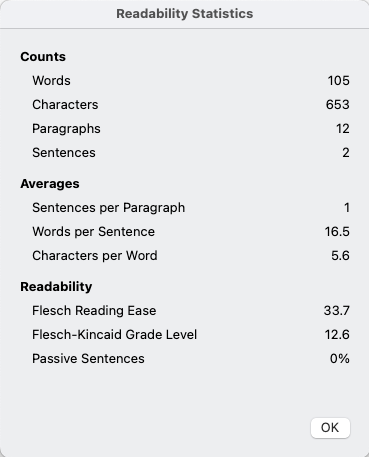Word Accessibility
Document Properties, Plain Language, and Fonts
A few initial steps to Word accessibility include using plain language, choosing accessible fonts, and setting document properties.
On this page:
Accessible Font

Choose readable fonts to aid people with low vision, dyslexia, and other processing disorders to read content.
Best practices for fonts:
- Use sans-serif fonts like Aptos, Arial, Calibri, Helvetica, or Montserrat.
- Use simple serif fonts, such as Cambria, Sitka, and Times New Roman.
- Avoid exaggerated serifs, scripts, and novelty fonts.
- Use size 12 or greater
- Size 9 is acceptable for foot/endnotes or figure captions.
- Left-align text for languages that read left to right.
- Use at least 1.5 line spacing.
The Appearance chapter of this handbook has additional information on using accessible font.
Font Colour
For readers that have colour vision deficiency or low vision, ensure text has sufficient contrast. Good contrast makes text easier to read for everyone. Font must have a contrast ratio of at least 4.5:1 against the background. For example, black text on a white background has a contrast ratio of 21:1. Langara Orange (#F15A22) has a contrast ratio of 3.37:1, well below the accepted minimum.
To set font colour:
- Navigate to the Home tab.
- Select Font Colour.

- Select an appropriate colour or click Automatic.
Toggle on High-contrast only to only display colours with sufficient contrast.

Visit the accessible colour chapter of this Pressbook for more information.
Text Alignment
To set text alignment:
- Set alignment in the Paragraph tools on the Home tab.
- Avoid justified alignment as it can create excessive blocks of white space when zoomed and can create ‘rivers of white space’ which are gaps that appear to run through a paragraph due to coincidental alignment of spaces.
Text Spacing
To set spacing:
- Do not use Tab, Enter, or Space to change spacing between paragraphs or layout of bullet points:
- Navigate to Home > Line and Paragraph Spacing > Line Spacing Options
- The Paragraph dialogue has spacing options on the Indents and Spacing tab
- Navigate to Home > Line and Paragraph Spacing > Line Spacing Options
- Use Insert > Page Break to create page breaks
- Do not create manual spacing using Return or Space keys
- Do not use Tab, Space, or text boxes to create columns
- Go to Layout tab > Columns. Additional options are available by selecting More Columns…
Using Visual Style to Convey Meaning
Do not use visual style alone to convey information. Visual style could include:
- Italics
- Bold
- Underline
- Spatial positioning or text spacing
- Colours
Please use visual styling but include at least a second indicator, such as written instructions. Review the use of colour recommendations discussed earlier in this book.
Plain Language

Use the Editor tool to check reading level. Navigate to Home > Editor and select Document Stats. Aim for a Flesch-Kincaid Grade Level of 7-9 for general content. Learn more about plain language.
Document Properties
The document title is announced to assistive technology and is more informative (and pleasant to hear) than the file name. Adding a plain language title to the metadata allows continued adherence file naming conventions. Ensure the language code matches the language of the presentation. Other fields are useful but not required.
Document Title
Setting a title in a document’s metadata means screen reader software will read that title in place of a potentially unclear file name. If you use a file naming convention, some filenames could be quite cumbersome and unpleasant when read aloud. Best practice is to use the document’s heading as a title.
To add a document title:
- Navigate to File > info.
- On MacOS: File > Properties > Summary tab.
- Enter a descriptive title in the Title field.
This cannot be done in Office Online.
Document Language
To set document language to match content:
- Click language on Status Bar at bottom of document screen or via Tools > Language
- You can set a different language for different parts of your document:
- Select desired text.
- Via Review tab, select Language.
- Select appropriate language.
Colour contrast is the difference in saturation, brightness, and pigment of different elements relative to one another. A contrast ratio of at least 4.5:1 between text and background is required by common accessibility standards.
Language that is easily understood by the intended audience. Write for the audience using clear, simple language with focus on important information. Organize and group content.

